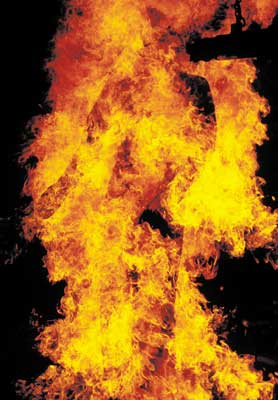
Courtesy Agromeck Yearbook
Fire. Smoke. Gas. Heat. Debris. Pain.
On Sept. 11, 2001, civilians, firefighters, paramedics, police officers, rescue workers and the like faced all these things and more with nothing more than courage, pride and the clothing on their backs.
Since the tragedy, the College of Textiles has been working with the Department of Homeland Security to improve that clothing.
Roger Barker, a professor in textiles and director of Textile Protection and Comfort Center, and his team are working to develop a new fire suit for firefighters that not only protects them better but is lighter and more flexible to increase comfort.
Barker, the principle investigator for the fire suit project, said the concept of the suit “came out of a need that was identified from Sept. 11.”
He indicated that there is a need for a suit to combat both biological and fire threats.
Although the development of new protective textile technologies has been a focal point of the College since Sept. 11, the need for protective clothing and equipment is always there, Barker said.
“In general, the Department of Homeland Security formed after Sept. 11, which increased national awareness for the need for technologies that connect with Sept. 11,” he said. “Even without Sept. 11, firefighters need protective clothing for everyday life, but Sept. 11 certainly increased that need.”
He said the new fire suit incorporates many new materials.
“The fire suit has a lot of different textile components in it,” he said, including a new nonwoven thermal liner.
He emphasized the challenge of finding the appropriate “trade-offs” between comfort and protection.
The development of the fire suit should conclude at the end of this year, Barker said, and after another year, due to necessary wear trials and certification, the suit may be available to firefighters.
“Our project has been well received,” he said, adding that a lot of the fire suit’s development comes from firefighter input.
Students in the College of Textiles recognize the change in their field of study since Sept. 11 and agree the development of new textile technologies is beneficial to the industry.
“The technical side of textiles has seen renewed purpose. Military needs have sparked new research in protective and ‘smart’ textiles,” Ian Raulston, a senior in textile management, said. “After Sept. 11, the U.S. military was interested in creating specialized military suits that protect troops from biological and chemical weapons, as well as fire repellence and other [protective properties].”
He said the profound interest in textile products post Sept. 11 is essential.
“This is a great opportunity for textile scientists and engineers to demonstrate the diversity and versatility of textile products,” he said.
Lindsay Barwegan, a senior in textile management, echoed Raulston’s thoughts on the need for military protection.
“Textiles have really come a long way since Sept. 11,” she said. “New products using materials like Kevlar are fire resistant and somewhat heat resistant. The College of Textiles has developed fabrics and clothing for the military that are the safest things they can wear out in combat.”
Changes in protective clothing and technologies are not the only adjustments the textile industry has made since Sept. 11, according to Raulston.
“Because of the war, there is less consumer confidence, especially with consumers [who] are older and have seen wartime economies before,” he said. “This lack of confidence is manifesting in less consumer spending on a variety of goods, especially textile-related products.”
He explained textiles are affected by many different facets and those affects are not always positive.
“The textiles industry is unique in that it is influenced by so many environmental factors. Even things as simple as a rainy day can influence consumer spending,” he said.
“The biggest influence on the industry post Sept. 11 has been fuel prices. This affects the industry in two ways: one, consumers have less income to spend on goods and two, the raw materials costs for common textile materials, such as polyester, are on the rise,” he said.
The textile industry has seen a decrease in consumer spending and an increase in the costs to manufacture goods, Raulster said.
“In a nutshell, people are buying fewer products and the cost to produce those products is increasing,” he said. “Not to mention the costs associated with security measures set into place post Sept. 11 that both the U.S. and global manufactures are paying.”
He did emphasize, however, that the current state of textiles is not solely related to Sept. 11, but has a lot to do with the elimination of textile quotas on Jan. 1, 2005.
New technologies and jobs have been developed since Sept. 11, but the industry has taken hits in other areas.
Either way, great pride is taken within the College of Textiles because of its involvement in creating better clothing and equipment for firefighters, the military and other protection and service related entities.
“It is gratifying,” Barker said. “We are really proud and happy to be a part of something that can have a good outcome in terms of protecting people.”